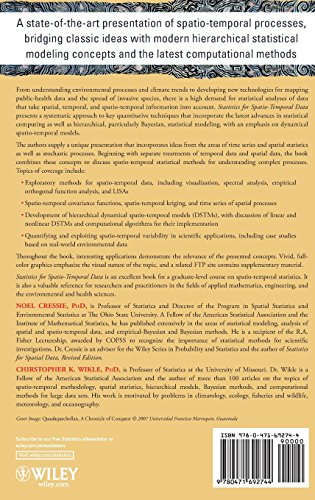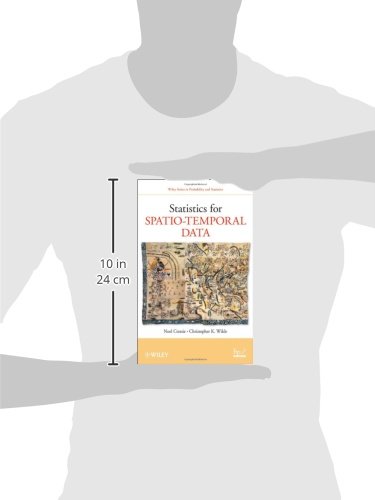



Full description not available
A**N
Interesting but a bit too ambitious and potentially misleading
Cressie and Wikle's book is one of the first to address space time models from a statistical point a view and using many of the latest statistical models (the soon to be updated 2003 book Hierarchical Modeling and Analysis for Spatial Data also covered the topic). Hierarchical space time models, Dynamical linear models, incorporating scientific knowledge into your statistical model, and handling massive data by using Fixed Rank Kriging are some of the topics covered. However, there are many intricacies that need to be addressed when modelling spatial data or temporal data. So writing a book covering data using both indices is no easy task. The task to write a book on spatio-temporal models only becomes harder when the goal is to cover the topic from a Bayesian point of view (a field of analysis with its own intricacies that need to be addressed). I believe the authors did a good job in presenting some of the latest space-time models proposed in research. However, there are big issues that are not covered in the book.- The importance of convergence diagnostics for Bayesian models must be emphasized one way or another when discussing these types of methods. The book pretty much does not touch on convergence at all.- Research has shown that Matern covariance parameters such as the smoothing parameter and the range, cannot be consistently estimated. This may lead to convergence problems when using MCMC techniques to extract characteristics from the posteriors of these parameters of interest (I found out about this the hard way as a grad student). As a result, at best, only partially reliable inference from your Bayesian analysis may be obtained, a disappointing fact given how computationally intensive Bayesian methods are for space-time models. Considering the major issue, space-time Bayesian models can hardly be called state of the art (as tagged several times in the book). Sadly, this convergence issue is not mentioned at all in the book which would lead to frustration for those constructing these models to try to understand a process of interest.- Kriging is referred to as the Best Linear Unbiased Predictor. In theory this is true, but this is assuming the spatial covariance parameters are known, which is not really the case in practice. Although this often does not affect much the results if the Gaussian distribution assumption holds, it may drastically affect prediction variances for non-Normal distributions. Cressie has done work on the subject. It appears this issue is not discussed in the book though and if so, it should be clearly emphasized.- Fixed Rank Kriging (FRK) is referred to as a best linear unbiased predictor. Is it not! In fact, since in practice kriging is often implemented by plugging in estimated parameters into the equations (making the the resulting estimated best linear unbiased predictor an approximation), FRK is truly an approximation of an approximation of the best linear unbiased predictor.The book proposes its methods as a way to conduct science the way it ought to be: in a critical way, transparent, reproducible and in an objective manner. But the points brought up above makes the book a bit disappointing since it is not critical about the methods that are proposed, which although useful, are certainly not perfect. If there is a new edition in the future, I suggest the authors cover some important material left out and also address some challenges faced when implementing these methods.
T**N
good but anticipate the next edition
This book contains some interesting topics like Kriging method and Kalman filtering. These two topics currently are used in Meteorological operation units, but not so many Meteorologists are familiar with. The authors combining the differential equations and probability models are very good try especially using different typing colors for different models; e.g. blue for process, green for data, red for posterior. However, the derivations of the equations are not so clear. The authors neither gave more details about the equations nor introduced the background motivations; for example, not introduce Kalman filtering's covariance update form from where. After all, this is a book not a journal papers. Anyway, I anticipate the next edition and hope the authors can discuss these things more.On the other hand, not about the contents of the book, the printing quality of the book is not good. It seems just using low-end and low-resolution laser printer to print this book. The words are blurred, and probably one droplet water can make the words faint. Also, the layout is poor like the lectures in class. I totally agree with one previous reviewer saying the bad printing quality of this book.
J**Y
Very comprehensive and clear coverage of formal mathematical spatiotemporal statistics
This is a massive, and authoritative treatise on spatio-temporal statistics. It focuses on formal mathematical treatments, and the maths can be intense, but if you really want to understand the theoretical underpinnings, and the tradeoffs between different approaches, this is a great book.I really like the attention to detail and couching everything in terms a hierarchy of models: Data (the connection between your actual measured values and the underlying "real" quantities), Process (the connection between the "real" quantities and the processes that create them), and Parameters (the parameters that characterize the process; the parameter model is intimately related to Bayesian priors). Cressie and Wikle's clarity about the distinctions between these different levels in the hierarchy really help me to clearly understand things that are blurred in other treatments.The authors take a largely Bayesian approach to modeling and analysis and present it clearly and compellingly. If you're serious about working with spatiotemporal data, this book belongs right next to Box and Jenkins on your bookshelf.
M**E
hardcopy maybe, do not buy the ebook (missing lots of mathematical characters and bad typeset)
While they tried to make an effort in having all the major formulas in picture format so that the formatting is somewhat preserved from the hard copy to the electronic version, the latter has lots of problems. A lot of the mathematical assumption and conditions embedded in the text were at best badly typesetted or have missing character and/or part of the equations. I bought the book for my pdD research, and all the missing information renders this book not quite useless but close. At this level, and for the price, (the electronic version is almost the same price than the printed version minus a couple dollars) I should have received the book in its integrity, not a sub-version of it with blanks to fill-in. The only reason I did not give this book less than 3 stars was because i checked the printed version and it seems pretty good. This e-book needs to be fixed.
L**T
Satisfied customer!
Great book!
T**R
Five Stars
This book is the most comprehensive overview of spatio-temporal statistics on the market.
A**R
Five Stars
Exactly as expected.
L**N
Hard to understand
This book is really hard to read. It may be written especially for statisticians, not general graduate students or researchers.
J**T
Five Stars
Very good!
P**G
Hardcopy is Fine but Electronic Edition is Useless
All is in the title. The book is a very comprehensive and motivating introduction to the domain. Avoid the electronic edition where many of the equations are incomplete or wrongly reproduced making this edition more or less useless. The editors probably did not check the transcription!
D**O
EStadística espacio-temporal
Es un libro que revisa los principales temas relacionados con la estadística espacio-temporal. Se presentan muchas referencia y ejemplos que han estudiado los autores
A**ー
Kindle本は数式が読めない
Kindle本を買ったのですが、数式が小さな画像になっていて、多くの箇所で読めないため、残念ですが返品をお願いしました。
Trustpilot
4 days ago
1 month ago